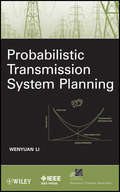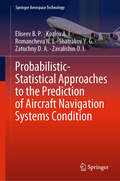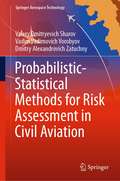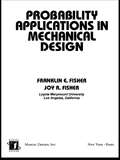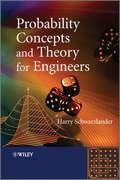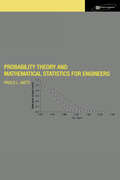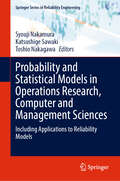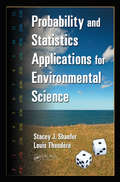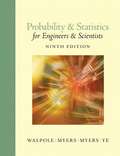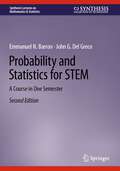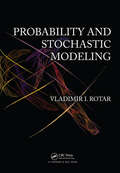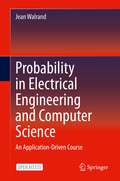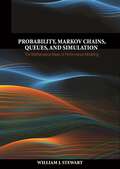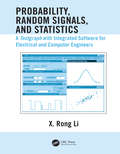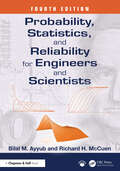- Table View
- List View
Probabilistic Transmission System Planning
by Wenyuan LiThe book is composed of 12 chapters and three appendices, and can be divided into four parts. The first part includes Chapters 2 to 7, which discuss the concepts, models, methods and data in probabilistic transmission planning. The second part, Chapters 8 to 11, addresses four essential issues in probabilistic transmission planning applications using actual utility systems as examples. Chapter 12, as the third part, focuses on a special issue, i.e. how to deal with uncertainty of data in probabilistic transmission planning. The fourth part consists of three appendices, which provide the basic knowledge in mathematics for probabilistic planning.
Probabilistic-Statistical Approaches to the Prediction of Aircraft Navigation Systems Condition (Springer Aerospace Technology)
by Eliseev B. P. Kozlov A. I. Romancheva N. I. Shatrakov Y. G. Zatuchny D. A. Zavalishin O. I.This book highlights the development of new methods for assessing and forecasting the state of various complex ageing systems in service; analyzing the influence of destabilizing factors on the accuracy of aircraft flight navigation support; and making recommendations on the ideal aircraft route, taking into consideration the available information on the reliability of the navigation and communication equipment.
Probabilistic-Statistical Methods for Risk Assessment in Civil Aviation (Springer Aerospace Technology)
by Dmitry Alexandrovich Zatuchny Valery Dmitryevich Sharov Vadim Vadimovich VorobyovThis book analyses the models for major risks related to flight safety in the aviation sector and presents risk estimation methods through examples of several known aviation enterprises. The book provides a comprehensive content for professionals engaged in the development of flight safety regulatory framework as well as in the design and operation of ground-based or on-board flight support radio electronic systems. The book is also useful for senior students and postgraduates in aviation specialties, especially those related to air traffic management.
Probability Applications in Mechanical Design (Mechanical Engineering)
by Franklin E. Fisher Joy R. FisherThe authors of this text seek to clarify mechanical fatigue and design problems by applying probability and computer analysis, and further extending the uses of probability to determine mechanical reliability and achieve optimization. The work solves examples using commercially available software. It is formatted with examples and problems for use
Probability Concepts and Theory for Engineers
by Harry SchwarzlanderA thorough introduction to the fundamentals of probability theoryThis book offers a detailed explanation of the basic models and mathematical principles used in applying probability theory to practical problems. It gives the reader a solid foundation for formulating and solving many kinds of probability problems for deriving additional results that may be needed in order to address more challenging questions, as well as for proceeding with the study of a wide variety of more advanced topics.Great care is devoted to a clear and detailed development of the 'conceptual model' which serves as the bridge between any real-world situation and its analysis by means of the mathematics of probability. Throughout the book, this conceptual model is not lost sight of. Random variables in one and several dimensions are treated in detail, including singular random variables, transformations, characteristic functions, and sequences. Also included are special topics not covered in many probability texts, such as fuzziness, entropy, spherically symmetric random variables, and copulas.Some special features of the book are:a unique step-by-step presentation organized into 86 topical Sections, which are grouped into six Parts over 200 diagrams augment and illustrate the text, which help speed the reader's comprehension of the material short answer review questions following each Section, with an answer table provided, strengthen the reader's detailed grasp of the material contained in the Section problems associated with each Section provide practice in applying the principles discussed, and in some cases extend the scope of that material an online separate solutions manual is available for course tutors. The various features of this textbook make it possible for engineering students to become well versed in the 'machinery' of probability theory. They also make the book a useful resource for self-study by practicing engineers and researchers who need a more thorough grasp of particular topics.
Probability Foundations for Engineers
by Joel A. NachlasThis textbook will continue to be the best suitable textbook written specifically for a first course on probability theory and designed for industrial engineering and operations management students. The book offers theory in an accessible manner and includes numerous practical examples based on engineering applications. Probability Foundations for Engineers, Second Edition continues to focus specifically on probability rather than probability and statistics. It offers a conversational presentation rather than a theorem or proof and includes examples based on engineering applications as it highlights Excel computations. This new edition presents a review of set theory and updates all descriptions, such as events versus outcomes, so that they are more understandable. Additional new material includes distributions such as beta and lognormal, a section on counting principles for defining probabilities, a section on mixture distributions and a pair of distribution summary tables. Intended for undergraduate engineering students, this new edition textbook offers a foundational knowledge of probability. It is also useful to engineers already in the field who want to learn more about probability concepts. An updated solutions manual is available for qualified textbook adoptions.
Probability Foundations for Engineers
by Joel A. NachlasSuitable for a first course in probability theory, this textbook covers theory in an accessible manner and includes numerous practical examples based on engineering applications. The book begins with a summary of set theory and then introduces probability and its axioms. It covers conditional probability, independence, and approximations. An important aspect of the text is the fact that examples are not presented in terms of "balls in urns". Many examples do relate to gambling with coins, dice and cards but most are based on observable physical phenomena familiar to engineering students.
Probability Models in Operations Research (Operations Research Series)
by Joel A. Nachlas C. Richard CassadyIndustrial engineering has expanded from its origins in manufacturing to transportation, health care, logistics, services, and more. A common denominator among all these industries, and one of the biggest challenges facing decision-makers, is the unpredictability of systems. Probability Models in Operations Research provides a comprehensive
Probability Theory and Mathematical Statistics for Engineers
by Paolo L. GattiProbability Theory and Statistical Methods for Engineers brings together probability theory with the more practical applications of statistics, bridging theory and practice. It gives a series of methods or recipes which can be applied to specific problems.This book is essential reading for practicing engineers who need a sound background knowledge
Probability Theory: A Comprehensive Course (Universitext)
by Achim KlenkeThis popular textbook, now in a revised and expanded third edition, presents a comprehensive course in modern probability theory.Probability plays an increasingly important role not only in mathematics, but also in physics, biology, finance and computer science, helping to understand phenomena such as magnetism, genetic diversity and market volatility, and also to construct efficient algorithms. Starting with the very basics, this textbook covers a wide variety of topics in probability, including many not usually found in introductory books, such as: limit theorems for sums of random variables martingales percolation Markov chains and electrical networks construction of stochastic processes Poisson point process and infinite divisibility large deviation principles and statistical physics Brownian motion stochastic integrals and stochastic differential equations. The presentation is self-contained and mathematically rigorous, with the material on probability theory interspersed with chapters on measure theory to better illustrate the power of abstract concepts.This third edition has been carefully extended and includes new features, such as concise summaries at the end of each section and additional questions to encourage self-reflection, as well as updates to the figures and computer simulations. With a wealth of examples and more than 290 exercises, as well as biographical details of key mathematicians, it will be of use to students and researchers in mathematics, statistics, physics, computer science, economics and biology.
Probability and Random Processes for Electrical and Computer Engineers
by John A. GubnerThe theory of probability is a powerful tool that helps electrical and computer engineers to explain, model, analyze, and design the technology they develop. The text begins at the advanced undergraduate level, assuming only a modest knowledge of probability, and progresses through more complex topics mastered at graduate level. The first five chapters cover the basics of probability and both discrete and continuous random variables. The later chapters have a more specialized coverage, including random vectors, Gaussian random vectors, random processes, Markov Chains, and convergence. Describing tools and results that are used extensively in the field, this is more than a textbook; it is also a reference for researchers working in communications, signal processing, and computer network traffic analysis. With over 300 worked examples, some 800 homework problems, and sections for exam preparation, this is an essential companion for advanced undergraduate and graduate students. Further resources for this title, including solutions (for Instructors only), are available online at www. cambridge. org/9780521864701.
Probability and Random Variables for Electrical Engineering: Probability: Measurement of Uncertainty (Studies in Systems, Decision and Control #390)
by Witold Pedrycz Tofigh Allahviranloo Muammer CatakThis book delivers a concise and carefully structured introduction to probability and random variables. It aims to build a linkage between the theoretical conceptual topics and the practical applications, especially in the undergraduate engineering area. The book motivates the student to gain full understanding of the fundamentals of probability theory and help acquire working problem-solving skills and apply the theory to engineering applications. Each chapter includes solved examples at varying levels (both introductory and advanced) in addition to problems that demonstrate the relevance of the probability and random variables in engineering. As authors, we focused on to find out the optimum ways in order to introduce the topics in probability and random variables area.
Probability and Statistical Models in Operations Research, Computer and Management Sciences: Including Applications to Reliability Models (Springer Series in Reliability Engineering)
by Toshio Nakagawa Syouji Nakamura Katsushige SawakiThis book explores the convergence of stochastic modeling, reliability tools, and the quest for solutions in an era of globalized challenges. The tools have become only more important in the unforeseen emergencies such as the COVID-19 pandemic and the conflict in Ukraine. This comprehensive book is an invaluable resource for graduate students seeking practical knowledge on probability and statistics in real-world applications. The book is divided into four parts: reliability, computer science, management science, and operations research. Each part includes surveys, recent results, and tools used. Moreover, it offers an essential reference point for researchers, engineers, and managers operating in laboratories, industries, businesses, and government agencies. Through the exchange of academic achievements, ideas, and discussions, this book serves as a catalyst for progress and innovation.
Probability and Statistics Applications for Environmental Science
by Louis Theodore Stacey J ShaeferSimple, clear, and to the point, Probability and Statistics Applications for Environmental Science delineates the fundamentals of statistics, imparting a basic understanding of the theory and mechanics of the calculations. User-friendliness, uncomplicated explanations, and coverage of example applications in the environmental field set this book ap
Probability and Statistics for Engineers and Scientists (Ninth Edition)
by Raymond H. Myers Ronald E. Walpole Sharon L. Myers Keying E. YeThis classic text provides a rigorous introduction to basic probability theory and statistical inference, with a unique balance of theory and methodology. Interesting, relevant applications use real data from actual studies, showing how the concepts and methods can be used to solve problems in the field. This revision focuses on improved clarity and deeper understanding.
Probability and Statistics for STEM: A Course in One Semester (Synthesis Lectures on Mathematics & Statistics)
by Emmanuel N. Barron John G. Del GrecoThis new edition presents the essential topics in probability and statistics from a rigorous standpoint. Any discipline involving randomness, including medicine, engineering, and any area of scientific research, must have a way of analyzing or even predicting the outcomes of an experiment. The authors focus on the tools for doing so in a thorough, yet introductory way. After providing an overview of the basics of probability, the authors cover essential topics such as confidence intervals, hypothesis testing, and linear regression. These subjects are presented in a one semester format, suitable for engineers, scientists, and STEM students with a solid understanding of calculus. There are problems and exercises included in each chapter allowing readers to practice the applications of the concepts.
Probability and Stochastic Modeling
by Vladimir I. RotarA First Course in Probability with an Emphasis on Stochastic ModelingProbability and Stochastic Modeling not only covers all the topics found in a traditional introductory probability course, but also emphasizes stochastic modeling, including Markov chains, birth-death processes, and reliability models. Unlike most undergraduate-level probability t
Probability and Stochastic Processes for Physicists (UNITEXT for Physics)
by Nicola Cufaro PetroniThis book seeks to bridge the gap between the parlance, the models, and even the notations used by physicists and those used by mathematicians when it comes to the topic of probability and stochastic processes. The opening four chapters elucidate the basic concepts of probability, including probability spaces and measures, random variables, and limit theorems. Here, the focus is mainly on models and ideas rather than the mathematical tools. The discussion of limit theorems serves as a gateway to extensive coverage of the theory of stochastic processes, including, for example, stationarity and ergodicity, Poisson and Wiener processes and their trajectories, other Markov processes, jump-diffusion processes, stochastic calculus, and stochastic differential equations. All these conceptual tools then converge in a dynamical theory of Brownian motion that compares the Einstein–Smoluchowski and Ornstein–Uhlenbeck approaches, highlighting the most important ideas that finally led to a connection between the Schrödinger equation and diffusion processes along the lines of Nelson’s stochastic mechanics. A series of appendices cover particular details and calculations, and offer concise treatments of particular thought-provoking topics.
Probability in Electrical Engineering and Computer Science: An Application-Driven Course
by Jean WalrandThis revised textbook motivates and illustrates the techniques of applied probability by applications in electrical engineering and computer science (EECS). The author presents information processing and communication systems that use algorithms based on probabilistic models and techniques, including web searches, digital links, speech recognition, GPS, route planning, recommendation systems, classification, and estimation. He then explains how these applications work and, along the way, provides the readers with the understanding of the key concepts and methods of applied probability. Python labs enable the readers to experiment and consolidate their understanding. The book includes homework, solutions, and Jupyter notebooks. This edition includes new topics such as Boosting, Multi-armed bandits, statistical tests, social networks, queuing networks, and neural networks. For ancillaries related to this book, including examples of Python demos and also Python labs used in Berkeley, please email Mary James at mary.james@springer.com. This is an open access book.
Probability, Markov Chains, Queues, and Simulation: The Mathematical Basis of Performance Modeling
by William J. StewartProbability, Markov Chains, Queues, and Simulation provides a modern and authoritative treatment of the mathematical processes that underlie performance modeling. The detailed explanations of mathematical derivations and numerous illustrative examples make this textbook readily accessible to graduate and advanced undergraduate students taking courses in which stochastic processes play a fundamental role. The textbook is relevant to a wide variety of fields, including computer science, engineering, operations research, statistics, and mathematics.The textbook looks at the fundamentals of probability theory, from the basic concepts of set-based probability, through probability distributions, to bounds, limit theorems, and the laws of large numbers. Discrete and continuous-time Markov chains are analyzed from a theoretical and computational point of view. Topics include the Chapman-Kolmogorov equations; irreducibility; the potential, fundamental, and reachability matrices; random walk problems; reversibility; renewal processes; and the numerical computation of stationary and transient distributions. The M/M/1 queue and its extensions to more general birth-death processes are analyzed in detail, as are queues with phase-type arrival and service processes. The M/G/1 and G/M/1 queues are solved using embedded Markov chains; the busy period, residual service time, and priority scheduling are treated. Open and closed queueing networks are analyzed. The final part of the book addresses the mathematical basis of simulation.Each chapter of the textbook concludes with an extensive set of exercises. An instructor's solution manual, in which all exercises are completely worked out, is also available (to professors only).Numerous examples illuminate the mathematical theoriesCarefully detailed explanations of mathematical derivations guarantee a valuable pedagogical approachEach chapter concludes with an extensive set of exercises
Probability, Random Signals, and Statistics
by X. Rong LiWith this innovative text, the study-and teaching- of probability and random signals becomes simpler, more streamlined, and more effective. Its unique "textgraph" format makes it both student-friendly and instructor-friendly. Pages with a larger typeface form a concise text for basic topics and make ideal transparencies; pages with smaller type provide more detailed explanations and more advanced material.
Probability, Random Variables, and Data Analytics with Engineering Applications
by P. Mohana ShankarThis book bridges the gap between theory and applications that currently exist in undergraduate engineering probability textbooks. It offers examples and exercises using data (sets) in addition to traditional analytical and conceptual ones. Conceptual topics such as one and two random variables, transformations, etc. are presented with a focus on applications. Data analytics related portions of the book offer detailed coverage of receiver operating characteristics curves, parametric and nonparametric hypothesis testing, bootstrapping, performance analysis of machine vision and clinical diagnostic systems, and so on. With Excel spreadsheets of data provided, the book offers a balanced mix of traditional topics and data analytics expanding the scope, diversity, and applications of engineering probability. This makes the contents of the book relevant to current and future applications students are likely to encounter in their endeavors after completion of their studies. A full suite of classroom material is included. A solutions manual is available for instructors. Bridges the gap between conceptual topics and data analytics through appropriate examples and exercises; Features 100's of exercises comprising of traditional analytical ones and others based on data sets relevant to machine vision, machine learning and medical diagnostics;Intersperses analytical approaches with computational ones, providing two-level verifications of a majority of examples and exercises.
Probability, Statistics and Other Frightening Stuff (Working Guides to Estimating & Forecasting #2)
by Alan R. JonesProbability, Statistics and Other Frightening Stuff (Volume II of the Working Guides to Estimating & Forecasting series) considers many of the commonly used Descriptive Statistics in the world of estimating and forecasting. It considers values that are representative of the ‘middle ground’ (Measures of Central Tendency), and the degree of data scatter (Measures of Dispersion and Shape) around the ‘middle ground’ values. A number of Probability Distributions and where they might be used are discussed, along with some fascinating and useful ‘rules of thumb’ or short-cut properties that estimators and forecasters can exploit in plying their trade. With the help of a ‘Correlation Chicken’, the concept of partial correlation is explained, including how the estimator or forecaster can exploit this in reflecting varying levels of independence and imperfect dependence between an output or predicted value (such as cost) and an input or predictor variable such as size. Under the guise of ‘Tails of the unexpected’ the book concludes with two chapters devoted to Hypothesis Testing (or knowing when to accept or reject the validity of an assumed estimating relationship), and a number of statistically-based tests to help the estimator to decide whether to include or exclude a data point as an ‘outlier’, one that appears not to be representative of that which the estimator is tasked to produce. This is a valuable resource for estimators, engineers, accountants, project risk specialists as well as students of cost engineering.
Probability, Statistics, and Reliability for Engineers and Scientists
by Bilal M. Ayyub Richard H. McCuenVirtually every engineer and scientist must be able to collect, analyze, interpret, and properly use vast arrays of data. This means acquiring a solid foundation in the methods of data analysis and synthesis. Understanding the theoretical aspects is important, but learning to properly apply the theory to real-world problems is essential.The goal of this popular and proven book is to introduce the fundamentals of probability, statistics, reliability, and risk methods to engineers and scientists for the purpose of data and uncertainty analysis and modeling in support of decision-making. The primary objectives to the author’s approach include: (1) introducing probability, statistics, reliability, and risk methods to students and practicing professionals in engineering and the sciences; (2) emphasizing the practical use of these methods; and (3) establishing the limitations, advantages, and disadvantages of the methods. The book was developed with an emphasis on solving real-world technological problems that engineers and scientists are asked to solve as part of their professional responsibilities.Upon graduation, engineers and scientists must have a solid academic foundation in methods of data analysis and synthesis, as the analysis and synthesis of complex systems are common tasks that confront even entry-level professionals.The underlying theory, especially the assumptions central to the methods, is presented, but then the proper application of the theory is presented through realistic examples, often using actual data. Every attempt is made to show that methods of data analysis are not independent of each other. Instead, we show that real-world problem-solving often involves applying many of the methods presented in different chapters.Probability, Statistics, and Reliability for Engineers and Scientists, here in its fourth edition, is a very popular textbook. Ultimately, readers will find its content of great value in problem-solving and decision-making, particularly in practical applications.
Probability, Statistics, and Stochastic Processes for Engineers and Scientists (Mathematical Engineering, Manufacturing, and Management Sciences)
by Aliakbar Montazer Haghighi Indika WickramasingheFeaturing recent advances in the field, this new textbook presents probability and statistics, and their applications in stochastic processes. This book presents key information for understanding the essential aspects of basic probability theory and concepts of reliability as an application. The purpose of this book is to provide an option in this field that combines these areas in one book, balances both theory and practical applications, and also keeps the practitioners in mind. Features Includes numerous examples using current technologies with applications in various fields of study Offers many practical applications of probability in queueing models, all of which are related to the appropriate stochastic processes (continuous time such as waiting time, and fuzzy and discrete time like the classic Gambler’s Ruin Problem) Presents different current topics like probability distributions used in real-world applications of statistics such as climate control and pollution Different types of computer software such as MATLAB®, Minitab, MS Excel, and R as options for illustration, programing and calculation purposes and data analysis Covers reliability and its application in network queues
